|
|
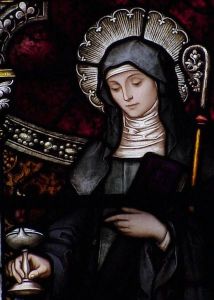 d. 523 at Kildare, Ireland
d. 523 at Kildare, IrelandDaughter of Dubtach, pagan Scottish king of Leinster, and Brocca, a Christian Pictish slave who had been baptized by Saint Patrick. Just before Brigid's birth, her mother was sold to a Druid landowner. Brigid remained with her mother till she was old enough to serve her legal owner Dubtach, her father. She grew up marked by her high spirits and tender heart, and as a child, she heard Saint Patrick preach, which she never forgot. She could not bear to see anyone hungry or cold, and to help them, often gave away things that were Dubtach's. When Dubtach protested, she replied that "Christ dwelt in every creature". Dubtach tried to sell her to the King of Leinster, and while they bargained, she gave a treasured sword of her father's to a leper. Dubtach was about to strike her when Brigid explained she had given the sword to God through the leper, because of its great value. The King, a Christian, forbade Dubtach to strike her, saying "Her merit before God is greater than ours". Dubtach solved this domestic problem by giving Brigid her freedom. Brigid's aged mother was in charge of her master's dairy. Brigid took charge ,and often gave away the produce. But the dairy prospered under her (hence her patronage of milk maids, dairy workers, cattle, etc.), and the Druid freed Brigid's mother. Brigid returned to her father, who arranged a marriage for her with a young bard. Bride refused, and to keep her virginity, went to her Bishop, Saint Mel of Ardagh, and took her first vows. Her first convent started c.468 with seven nuns. At the invitation of bishops, she started convents all over Ireland. She was a great traveler, especially considering the conditions of the time, which led to her patronage of travelers, sailors, etc. Brigid invented the double monastery, the monastery of Kildara, which means Church of the Oak, that she ran on the Liffey river being for both monks and nuns. Saint Conleth became its first bishop; this connection and the installation of a bell that lasted over 1000 years apparently led to her patronage of blacksmiths and those in related fields. "I would like the angels of Heaven to be among us. I would like an abundance of peace. I would like full vessels of charity. I would like rich treasures of mercy. I would like cheerfulness to preside over all. I would like Jesus to be present. I would like the three Marys of illustrious renown to be with us. I would like the friends of Heaven to be gathered around us from all parts. I would like myself to be a rent payer to the Lord; that I should suffer distress, that he would bestow a good blessing upon me. I would like a great lake of beer for the King of Kings. I would like to be watching Heaven's family drinking it through all eternity." - Saint Brigid 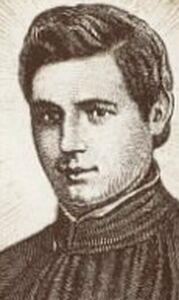 b. 1829 at Saint-Loup, diocese of Poitiers, France
b. 1829 at Saint-Loup, diocese of Poitiers, Franced. beheaded on February 2, 1861 at Hanoi, Tonkin (in modern Vietnam) Raised in a pious family; one brother became a priest, and was later curator for Theophane's writings, and another was the bishop of Poitiers, France. Studied at the College of Doue-la-Fontaine, Montmorillon, Poitiers, and the Paris Seminary for Foreign Missions. Ordained on 5 June 1852. Missionary to southeast Asia, leaving on 19 September 1852. Worked fifteen months at Hong Kong, then transferred to West Tonkin (in modern Vietnam). Christians in the area were being persecuted by order of the ruler Minh-Menh. Just before Theophan's arrival, new anti-Christian orders had forced priests and bishops to go into hiding in forests and caves. Father Venard, whose health had never been good, suffered terribly, ministering to his flock by night and, when he could find a secure location, by day for nearly four years. Betrayed by an ostensible parishioner, he was arrested on 30 November 1860. He was tried for the crime of being Christian, and was given ample opportunity to save himself by denying Christ; he declined. He was kept in a cage for several weeks prior to his execution, during which he wrote a series of joyful, consoling letters to his family. One of the Martyrs of Vietnam. "A slight sabre-cut will separate my head from my body, like the spring flower which the Master of the garden gathers for His pleasure. We are all flowers planted on this earth, which God plucks in His own good time: some a little sooner, some a little later. Father and son may we meet in Paradise. I, poor little moth, go first. Adieu." - Saint Theophane in a letter to his father just before his martyrdom  d. flesh torn by iron wool-combs, then beheaded c.316
d. flesh torn by iron wool-combs, then beheaded c.316Physician. Bishop of Sebaste, Armenia. Lived in a cave on Mount Argeus. Healer of men and animals; according to legend, sick animals would come to him on their own for help, but would never disturb him at prayer. Agricola, governor of Cappadocia, came to Sebaste to persecute Christians. His huntsmen went into the forests of Argeus to find wild animals for the arena games, and found many waiting outside Blaise's cave. Discovered in prayer, Blaise was arrested, and Agricola tried to get him to recant his faith. While in prison, Blaise ministered to and healed fellow prisoners, including saving a child who was choking on a fish bone; this led to the blessing of throats on Blaise's feast day. Thrown into a lake to drown, Blaise stood on the surface and invited his persecutors to walk out and prove the power of their gods; they drowned. When he returned to land, he was martyred by being beaten, his flesh torn with wool combs (which led to his association with and patronage of those involved in the wool trade), and then beheading. Blaise has been extremely popular for centuries in both the Eastern and Western Churches. In 1222 the Council of Oxford prohibited servile labor in England on his feast. He is one of the Fourteen Holy Helpers Through the intercession of Saint Blaise, bishop and martyr, may God deliver you from ailments of the throat and from every other evil. In the name of the Father, and of the Son, and of the Holy Spirit. Amen. - blessing of Saint Blaise 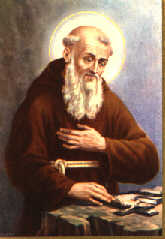 1556-1612.
1556-1612.Third of eight children born to John Desideri, a wool merchant, and Serafina Paolini. His parents died when the boy was 12 years old, and he was raised and educated by his uncle Battista Desideri, a teacher in Viterbo, Italy. Desideri arranged a marriage for Eufranio with a local noble family, but the young man felt a call to religious life. Worry over his vocation, and fear of hurting his uncle, made Eufranio sick; he returned to Leonessa, Italy to recover. There he met, and was greatly impressed by, a group of Capuchin monks. When Eufranio told his uncle of his desire to join them, Desideri insisted that he continue his studies. Eufranio agreed, and moved to Spoleto, Italy to do so, but kept in contact with the monks. Following a novitiate year in which the monks did everything to test and dissuade the young man, he joined the Capuchin Franciscans on 8 January 1573 at age 18, taking the religious name Joseph. Suffered through several self-imposed austerities including fasting three days a week and sleeping on bare boards. Ordained at Amelia, Italy on 24 September 1580. Preacher throughout the regions of Umbria, Lazio and Abruzzi regions of Italy. Father Joseph once converted an entire band of 50 highway bandits, who then showed up as a group for his Lent sermons. Missionary to Muslim Pera near Constantinople (modern Istanbul, Turkey), receiving his commission on 1 August 1587. Chaplain for 4,000 Christian galley slaves. He often offered to take the place of some slave who was being worked to death, but the authorities never accepted. Ministering to prisoners in a remote camp, he once got home late, and was forced to sleep outside the walls of his assigned area; he was charged with being a spy for being in the wrong place, and spent a month in jail. He preached to any who would listen, brought lapsed Christians back to the Church and converted Muslims. Worked with prisoners during a plague outbreak. Joseph repeatedly sought an audience with the Sultan; he planned to ask for a decree of religious freedom. His forceful methods led to his being arrested and condemned to death for trespassing on royal property. Hung by hooks over a smoky fire for three days, he was freed (legend says by an angel), and returned to Italy, in autumn 1589. There he resumed his vocation of wandering preacher to small villages throughout the country. Preached to and for the poor, and spread the teachings of the Council of Trent. Helped establish hospitals, homeless shelters, and food banks. Ministered in prisons, to the sick, and the poor. With his crucifix in hand, he would wade into gang fights and brawls, praying, and preaching peace and good sense. "Every Christian must be a living book wherein one can read the teaching of the gospel. This is what Saint Paul says to the Corinthians, 'Clearly you are a letter of Christ which I have delivered, a letter written not with ink, but by the Spirit of the living God, not on tablets of stone but on tablets of flesh in the heart' (2 Corinthians 3:3). Our heart is the parchment; through my ministry the Holy Spirit is the writer because 'my tongue is nimble as the pen of a skillful scribe'(Psalms 45:2)." - from a sermon by Saint Joseph of Leonessa 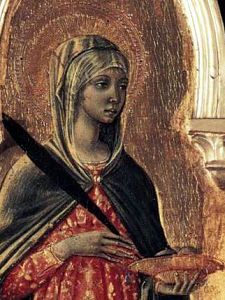 Martyred c.250 at Catania, Sicily.
Martyred c.250 at Catania, Sicily.We have little reliable information about this martyr, who has been honored since ancient times, and whose name is included in the canon of the Mass. Young, beautiful and rich, Agatha lived a life consecrated to God. When Decius announced the edicts against Christians, the magistrate Quinctianus tried to profit by Agatha's sanctity; he planned to blackmail her into sex in exchange for not charging her. Handed over to a brothel, she refused to accept customers. After rejecting Quinctianus's advances, she was beaten, imprisoned, tortured, her breasts were crushed and cut off. She told the judge, "Cruel man, have you forgotten your mother and the breast that nourished you, that you dare to mutilate me this way?" She was then imprisoned again, then rolled on live coals; Agatha thanked God for an end to her pain, and died. Her intercession is reported to have saved Malta from Turkish invasion in 1551. "My fellow Christians, our annual celebration of a martyr's feast has brought us together. Agatha achieved renown in the early Church for her noble victory. For her, Christ's death was recent, his blood was still moist. Her robe is the mark of her faithful witness to Christ. Agatha, the name of our saint, means "good." She was truly good, for she lived as a child of God. Agatha, her goodness coincides with her name and her way of life. She won a good name by her noble deeds, and by her name she points to the nobility of those deeds. Agatha, her mere name wins all men over to her company. She teaches them by her example to hasten with her to the true Good, God alone." - from a homily on Saint Agatha by Saint Methodius of Sicily 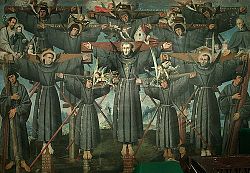 Born: 1562 at Tsunokuni, Japan
Born: 1562 at Tsunokuni, Japan Died: crucified on Feb. 5, 1597 at Nagasaki, Japan Born wealthy, the son of the military leader Miki Handayu. Felt a call to religious life from his youth. Jesuit in 1580, educated at the Jesuit college at Azuchi and Takatsuki. Successful evangelist. When the political climate became hostile to Christianity, he decided to continue his ministry, was soon arrested. On his way to martyrdom, he and other imprisoned Christians were marched 600 miles so they could be abused by, and be a lesson to, their countrymen; they sang the Te Deum on the way. His last sermon was delivered from the cross. One of the Martyrs of Nagasaki. "The only reason for my being killed is that I have taught the doctrine of Christ. I thank God it is for this reason that I die. I believe that I am telling the truth before I die. I know you believe me and I want to say to you all once again: Ask Christ to help you become happy. I obey Christ. After Christ's example, I forgive my persecutors. I do not hate them. I ask God to have pity on all, and I hope my blood will fall on my fellow men as a fruitful rain." - Saint Paul Miki  Born: 1825 at Lille, France
Born: 1825 at Lille, FranceDied: 1871 at Paris, France of cancer Friend of Saint John Vianney. Felt a call to acts of charity made on behalf of souls in purgatory. Founded the Auxiliatrices des Ames du Purgatoire (Society of Helpers of the Holy Souls) in Paris, France on 19 January 1856. The Society continues its missionary work today in 22 countries. "If one of our friends was imprisoned in a house of fire, how we should rush to her help. Then think how we should try to deliver the souls in Purgatory." - Blessed Eugenie Smet  Born: 1868, Oglassa, Darfur, Sudan
Born: 1868, Oglassa, Darfur, SudanDied: Feb. 8, 1947 of natural causes in Italy Born to a wealthy Sudanese family, she was kidnapped by slave-traders at age 9, and given the name Bakhita (lucky) by them. Sold and resold in the markets at El Obeid and Khartoum, finally purchased in 1883 by Callisto Legnani, Italian consul who planned to free her. She accompanied Legnani to Italy in 1885, and worked as a nanny for the family of Augusto Michieli. She was treated well in Italy and grew to love the country. An adult convert the Christianity, she joined the Church on 9 January 1890, she took the name of Josephine as a symbol of her new life. She entered the Institute of Canossian Daughters of Charity in Venice, Italy in 1893, taking her vows on 8 December 1896 in Verona, Italy and serving as a Canossian Sister for the next fifty years. Her gentle presence, her warm, amiable voice, and her willingness to help with any menial task were a comfort to the poor and suffering people who came to the door of the Institute. After a biography of her was published in 1930, she became a noted and sought after speaker, raising funds to support missions. "If I were to meet the slave-traders who kidnapped me and even those who tortured me, I would kneel and kiss their hands, for if that did not happen, I would not be a Christian and Religious today." - Saint Josephine Bakhita 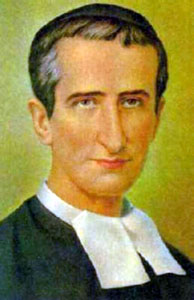 Born: 1854 at Cuenca, Ecuador
Born: 1854 at Cuenca, EcuadorDied: Feb. 9, 1910 of pneumonia at Premia del Mar, Spain, and buried there. His grave was disturbed during the Spanish Civil War, and his body found incorrupt. Born to a prominent family. Born with an unknown disability, he was unable to stand until age five when he received a vision of Our Lady. At age eight he was miraculously protected from being mauled by a wild bull. In 1863, at age nine, he enrolled in a school run by the Christian Brothers, an Order which had only recently come to Ecuador. Joined the Brothers on 24 March 1868 at age 13. School teacher at El Cebollar School, Quito, a position he held for 32 years. A gentle, dedicated, and enthusiastic teacher. Wrote his own textbooks, the first at age 17; some were adopted by the government, and used throughout the country. Wrote odes, hymns, discourses on teaching methods, plays, inspirational works, and retreat manuals. Elected to the Ecuadoran Academy of Letters in 1892, followed soon after by the Academies of Spain, France, and Venezuela. Conducted religious retreats, and prepared children for their First Communion. Novice director for his house from 1901 to 1904. Sent to Europe in 1905 to translate texts from French to Spanish for use by the Order; worked primarily in Belgium. His health began to fail in 1908, and he was transferred to the school near Barcelona, Spain. He continued to work, but slowly, his health continued to fail, and he died there in 1910. In addition to being a religious role model, Miguel is considered a national hero in Ecuador for his success in so many worthwhile areas. "The heart is rich when it is content, and it is always content when its desires are fixed on God." - Saint Miguel  Born: 480, Italy
Born: 480, ItalyDied: 543 Twin sister of Saint Benedict of Nursia. Born to the Italian nobility. Her mother died in childbirth. Nun. She led a community of women at Plombariola near Montecassino. "Scholastica, the sister of Saint Benedict, had been consecrated to God from her earliest years. She was accustomed to visiting her brother once a year. He would come down to meet her at a place on the monastery property, not far outside the gate. One day she came as usual and her saintly brother went with some of his disciples; they spent the whole day praising God and talking of sacred things. As night fell they had supper together. Their spiritual conversation went on and the hour grew late. The holy nun said to her brother, "Please do not leave me tonight; let us go on until morning talking about the delights of the spiritual life." "Sister," he replied, "What are you saying? I simply cannot stay outside my cell." When she heard her brother refuse her request, the holy woman joined her hands on the table, laid her head on them and began to pray. As she raised her head from the table, there were such brilliant flashes of lightning, such great peals of thunder and such a heavy downpour of rain that neither Benedict nor his brethren could stir across the threshold of the place where they had been seated. Sadly, he began to complain. "May God forgive you, sister. What have you done?" "Well, she answered, "I asked you and you would not listen; so I asked my God and he did listen. So now go off, if you can, leave me and return to your monastery." So it came about that they stayed awake the whole night, engrossed in their conversation about the spiritual life. Three days later, Benedict was in his cell. Looking up to the sky, he saw his sister's soul leave her body in the form of a dove, and fly up to the secret places of heaven. Rejoicing in her great glory, he thanked almighty God with hymns and words of praise. He then sent his brethren to bring her body to the monastery and lay it in the tomb he had prepared for himself." - from Dialogues by Pope Saint Gregory the Great 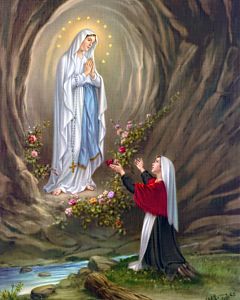 On February 11, 1858, a young lady appeared to Bernadette Soubirous. This began a series of visions. During the apparition on March 25, the lady identified herself with the words: "I am the Immaculate Conception."
On February 11, 1858, a young lady appeared to Bernadette Soubirous. This began a series of visions. During the apparition on March 25, the lady identified herself with the words: "I am the Immaculate Conception."Bernadette was a sickly child of poor parents. Their practice of the Catholic faith was scarcely more than lukewarm. Bernadette could pray the Our Father, the Hail Mary and the Creed. She also knew the prayer of the Miraculous Medal: "O Mary conceived without sin." During interrogations Bernadette gave an account of what she saw. It was "something white in the shape of a girl." She used the word aquero, a dialect term meaning "this thing." It was "a pretty young girl with a rosary over her arm." Her white robe was encircled by a blue girdle. She wore a white veil. There was a yellow rose on each foot. A rosary was in her hand. Bernadette was also impressed by the fact that the lady did not use the informal form of address (tu), but the polite form (vous). The humble virgin appeared to a humble girl and treated her with dignity. Through that humble girl, Mary revitalized and continues to revitalize the faith of millions of people. People began to flock to Lourdes from other parts of France and from all over the world. In 1862 Church authorities confirmed the authenticity of the apparitions and authorized the cult of Our Lady of Lourdes for the diocese. The Feast of Our Lady of Lourdes became worldwide in 1907. Prayer to Our Lady of Lourdes... O ever-Immaculate Virgin, Mother of Mercy, health of the sick, refuge of sinners, comforter of the afflicted, you know my wants, my troubles, my sufferings; look with mercy on me. By appearing in the Grotto of Lourdes, you were pleased to make it a privileged sanctuary, whence you dispense your favors; and already many sufferers have obtained the cure of their infirmities, both spiritual and corporal. I come, therefore, with complete confidence to implore your maternal intercession. Obtain, O loving Mother, the grant of my requests. Through gratitude for your favors, I will endeavor to imitate your virtues, that I may one day share your glory. Amen.  d. 1261, the eldest of the Seven Holy Founders of the Servants of Mary, and the first superior of the Servite Order.
d. 1261, the eldest of the Seven Holy Founders of the Servants of Mary, and the first superior of the Servite Order.He was one of seven Florentines who had joined the Confraternity of the Blessed Virgin (the Laudesi) in a particularly lax period in the city's history and who were inspired by a vision on the feast of the Assumption to take up a life of solitude and prayer. After nearly fifteen years of austerity at a hermitage on Monte Senario he took the name in 1240 of Servants of Mary, or Servites. Six were ordained, developed as mendicant friars under the direction of James of Poggibonsi and Bishop Ardingo of Florence and established many houses and foreign missions. Br. Buonfiglio served as its first prikor general from 1240 to 1256 and died on Jan 1. St. John Buonagiunta succeded him, St. Bartholomew Amidei (Br. Hugh) established the order in Paris and St. Ricovero Ugoccione (Br. Sostenesw) in Germany. SS. Benedict dell'Antella (Br. Manettus) were ordained; St. Alexis Falconieri became a lay brother and was the only one to live to see the order approved by Pope Benedict XI in 1304. The "Seven Holy Founders" of the Servites were canonized in 1887 by Pope Leo XIII. Prayer... Father in heaven, May the life of Saint Buonfiglio Monaldo help us understand that we will never be alone since you are always with us. We ask this through Christ our Lord. Amen.  Born in 1522 to the patrician class. Her mother died when Catherine was an infant; she was raised by her godmother, but considered the Blessed Virgin Mary to be her true mother, and developed a great devotion to her. As a child, Catherine could speak to her guardian angel, and the angel taught her prayers for the rosary. At age 6 she moved to the convent school of Montecelli; her aunt was the abbess. Catherine developed a devotion to the Passion. Her father, Peter, objected to her plans to join a convent, then relented, then changed his mind again. Catherine continued her prayers at home, but when he changed his mind she fell ill. It was only when he at last agreed on her vocation that she recovered. Dominican tertiary.
Born in 1522 to the patrician class. Her mother died when Catherine was an infant; she was raised by her godmother, but considered the Blessed Virgin Mary to be her true mother, and developed a great devotion to her. As a child, Catherine could speak to her guardian angel, and the angel taught her prayers for the rosary. At age 6 she moved to the convent school of Montecelli; her aunt was the abbess. Catherine developed a devotion to the Passion. Her father, Peter, objected to her plans to join a convent, then relented, then changed his mind again. Catherine continued her prayers at home, but when he changed his mind she fell ill. It was only when he at last agreed on her vocation that she recovered. Dominican tertiary.She received visions and had ecstacies, but these caused some problems and doubts among her sisters - outwardly she seemed asleep or dully stupid when the visions were upon her. Catherine thought everyone received these visions as part of their lives with God. She was stricken with a series of painful ailments that permanently damaged her health. Catherine met Philip Neri in a vision while he was alive in Rome; they corresponded. She could bilocate. Said to have received a ring from the Lord as a sign of her espousal to him; to her it appeared as gold set with a diamond; everyone else saw a red lozenge and a circlet around her finger. Permanent stigmatist. At age 20 she began a 12-year cycle of weekly ecstasies of the Passion from noon Thursday until 4:00pm Friday, often accompanied by serious wounds. Her sisters could follow the course of the Passion, as the wounds appeared in order from the scourging and crowning with thorns. At the end she was covered with wounds and her shoulder was indented from the Cross. The first time, during Lent 1542, she meditated so completely on the crucifixion of Jesus that she became ill, and was healed by a vision of the Risen Lord talking with Mary Magdalene. Crowds came to see her, skeptics and sinners being converted by the sight. The crowds became to numerous and constant that the sisters prayed that the wounds become less visible; He made them so in 1554. Three future popes (Cardinals Cervini, Pope Marcellus II; Alexander de Medici, Pope Leo XI; Aldobrandini, Pope Clement VIII) were among the thousands who sought her prayers. Novice-mistress. Sub-prioress. Prioress at age 30. Noted reformer of her house. Correspondent with Saint Charles Borromeo and Pope Saint Pius V. Died in 1590. 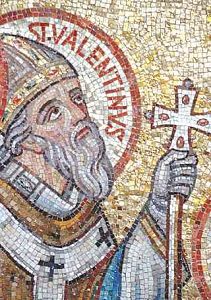 Saint Valentine was a bishop and is thought to have been a physician. He was arrested for giving aid to Christian prisoners awaiting martyrdom. While imprisoned he converted the jailer by restoring sight to the jailer's daughter. Saint Valentine refused to deny Christ before the Emperor Claudius in the year 280 and won the jeweled crown of martyrdom by his faithful witness. The feast of Saint Valentine was first established in 496 by Pope Gelasius I.
Saint Valentine was a bishop and is thought to have been a physician. He was arrested for giving aid to Christian prisoners awaiting martyrdom. While imprisoned he converted the jailer by restoring sight to the jailer's daughter. Saint Valentine refused to deny Christ before the Emperor Claudius in the year 280 and won the jeweled crown of martyrdom by his faithful witness. The feast of Saint Valentine was first established in 496 by Pope Gelasius I.Prayer to St. Valentine... O Saint Valentine, lover of Christ and of the Church, we ask your intercession that we may learn how to love God above all things, and to selflessly love one another. O glorious Saint Valentine, pray for us, that we too may have the steadfast faith of the martyrs. Amen.  1641-1682, Jesuit Priest
1641-1682, Jesuit PriestBorn to the French nobility, Claude early felt a call to religious life. Educated at Jesuit college in Lyons, France. Priest. Taught humanities at Avignon, France. Continued his studies in Paris, France. Tutor. Preached against Jansenism, advocating dedication to the Sacred Heart of Jesus. Joined the Jesuits in 1659. Spiritual director of Saint Margaret Mary of Alocoque. Chaplain to Mary Beatrice d'Este, the Duchess of York. He converted many Protestants through the example of his holy life. Due to rumors of "Popish plots" against the king and the re-establishment Catholicism, Claude was imprisoned, accused of being part of the Titus Oates Plot. It was only by the efforts of Louis XIV, who had recommended him for the assignment, that he was not martyred. Banished from England. His health had been ruined by his time in prison, and he returned to Paray to die. The day after his death, Saint Margaret received supernatural assurance that Claude needed no prayers, as he was in already heaven. He is considered a "dry" martyr, having suffered every abuse for the faith except death. Despair Prayer by St. Claude de la Colombiere... Lord, I am in this world to show Your mercy to others. Other people will glorify You by making visible the power of Your grace by their fidelity and constancy to You. For my part I will glorify You by making known how good You are to sinners, that Your mercy is boundless and that no sinner no matter how great his offenses should have reason to despair of pardon. If I have grievously offended You, My Redeemer, let me not offend You even more by thinking that You are not kind enough to pardon Me. Amen. - prayer by Saint Claude de la Colombiere 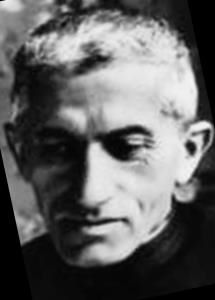 1851-1926, nephew of St. John Cafasso. St. John Bosco was one of Giuseppe's spiritual directors.
1851-1926, nephew of St. John Cafasso. St. John Bosco was one of Giuseppe's spiritual directors.Fourth of five children; nephew of Saint John Cafasso. His father died when Joseph was three years old. Studied at the Salesian Oratory in Valdocco, Italy; Saint John Bosco was one of Giuseppe's spiritual directors. He entered the diocesan seminary of Turin, Italy in November 1866. Ordained on 20 September 1873. Spiritual director of the Turin seminary. Appointed rector of the Consolata Shrine on 2 October 1880; he remodeled the shrine, and made it a source for spiritual renewal throughout the diocese. Founded the Consolata Missionary Priests and Brothers on 29 January 1901; the first missionaries reached Kenya in 1902. On 29 January 1910 he founded the Consolata Missionary Sisters for women with a missionary vocation. "From Heaven I will do more for you than I did here on earth." - Bl. Giuseppe Allamano, as he was dying 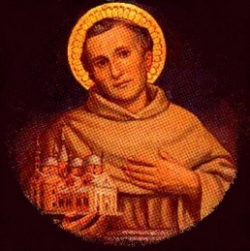 1200-1285, Received into the Order of Friars Minor, the Franciscans, by St. Francis of Assisi himself.
1200-1285, Received into the Order of Friars Minor, the Franciscans, by St. Francis of Assisi himself.Traveling companion and assistant to the great Franciscan preacher, St. Anthony of Padua. God our Father, you alone are holy; without you nothing is good. Trusting in the prayers of Bl. Luke Belludi we ask you to help us to become the holy people you call us to be. Never let us be found undeserving of the glory you have prepared for us. We ask this through our Lord Jesus Christ, your Son, who lives and reigns with you and the Holy Spirit, one God, for ever and ever. Amen. 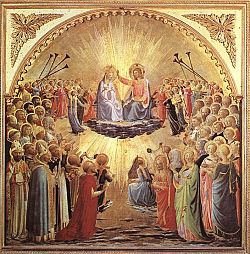 b. 1387, in Vicchio di Mugello, near Florence, Italy. Died, 1455.
b. 1387, in Vicchio di Mugello, near Florence, Italy. Died, 1455.Patron of Artists Joined the Dominicans in Fiesole, Italy in 1407, taking the name Fra Giovanna. He was taught to illuminate missals and manuscripts, and immediately exhibited a natural talent as an artist. Today his works can be seen in the Italian cities Cortona, Fiesole, Florence, and in the Vatican. His dedication to religious art earned him the title Angelico. Prayer to Blessed Fra Angelico.... Blessed Fra Angelico, you created works of beauty which have inspired countless souls into a closer union with God. By your intercession, may God raise up artists and craftsmen to beautify His holy dwellings and all churches to elevate human hearts and minds to a more profound relationship with the Almighty. Amen. Photo: The Coronation of the Virgin by Blessed Fra Angelico (1434-1435) Galleria degli Uffizi, Florence Italy 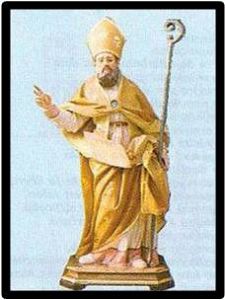 610-682, Bishop
610-682, BishopPriest at an early age. Fiery preacher whose flock turned on him because of his zeal; he finally resigned his parish and returned home. There he fought against a resurgent paganism involving the worship of a golden viper and animal skin hung in a tree. For unrelated reasons, the army of Emperor Constans, besieged Benevento; the locals soon listened to the preacher, renounced their errors, and stopped their idolatrous practices. Barbatus assured them that the siege would end; it did. The saint cut down the tree with his own hand, and melted down the golden viper to make a chalice for the altar. Bishop on 10 March 663. Eradicated superstition in the state. Assisted in a council called by Pope Agatho at Rome, Italy in 680. Attended the Sixth General Council held at Constantinople against the Monothelites in 681. Whoever humbles himself shall be exalted. -Lk. 14:11 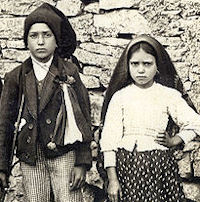 Two of the visionaries of Our Lady of Fatima in Portugal in 1917.
Two of the visionaries of Our Lady of Fatima in Portugal in 1917.Beatified by Pope John Paul II, May 13, 2000. Canonized by Pope Francis, May 13, 2017. Francisco Marto: Born June 11, 1908 at Aljustrel, Santarem, Portugal. Died: April 4, 1919 at Aljustrel, Portugal. Jacinta Marto: Born March 11, 1910 in Aljustrel, Santarem, Portugal. Died: February 20, 1920 in Lisbon, Portugal. One day in 1916, they saw an Angel, who told them he was the angel of peace and the guardian angel of Portugal. The angel taught the amazed children a prayer to say in reparation for sins: "My God, I believe, I adore, I hope, and I love You! I ask pardon of You for those who do not believe, do not adore, do not hope and do not love You!" 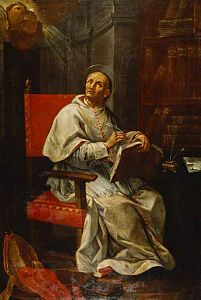 Bishop and Doctor of the Church
Bishop and Doctor of the Church1007-1072 Peter was born at Ravenna, Italy orphaned early, and after a youth spent in hardship and privation, showed such signs of remarkable intellectual gifts that his brother, Damian, who was archpriest at Ravenna, took him away to be educated. Adding his brother's name to his own, Peter made such rapid progress in his studies of theology and Canon law, first at Ravenna, then at Faenza, finally at Parma, that when about twenty-five years old he was already a famous teacher at Parma and Ravenna. Peter was a reformer and if he were alive today would no doubt encourage the renewal started by Vatican II. "...Let us faithfully transmit to posterity the example of virtue which we have received from our forefathers." (St. Peter Damian). 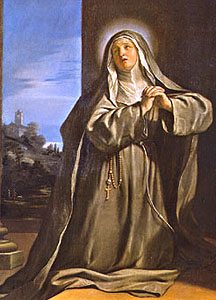 Born: 1247 at Loviano, Tuscany, Italy.
Born: 1247 at Loviano, Tuscany, Italy.Died: Feb. 22, 1297 at Cortona, Italy. Farmer's daughter. Her mother died when Margaret was seven years old, and her stepmother considered the girl a nuisance. Margaret eloped with a young nobleman from Montepulciano, bore him a son, and lived as his mistress for nine years. In 1274 he was murdered by brigands, and his body dumped in a shallow grave. Margaret saw the incident as a sign from God. She publicly confessed to the affair, and tried to return to her father's house; he would not accept her. She and her son took shelter with the Friars Minor at Cortona. Still young and attractive, Margaret sometimes had trouble resisting temptation, but each incident was followed by periods of deep self-loathing. To make herself unappealing to local young men, she once tried to mutilate herself, but was stopped by a Friar named Giunta. She earned her keep by tending to sick women. She later began caring for the sick poor, living on alms, asking nothing for her services. She became a Franciscan tertiary in 1277. Margaret developed an deep and intense prayer life, and was given to ecstacies during which she received messages from heaven. In 1286 Margaret received a charter to work with the sick poor. She gathered others of like mind, and formed them into a community of tertiaries. They were later given the status of a congregation, and called the Poverelle (Poor Ones). With them she founded a hospital at Cortona. Margaret preached against vice of all sorts to any who would listen. She developed a great devotion to the Eucharist and Passion, and prophesied the date of her own death. Though she worked for those in need, and though the poor sought her help and advice, the calumny of her earlier life followed her the rest of her days, and she was forever the target of local gossips. Prayer of Pope John Paul II in 1999... O Saint Margaret of Cortona, I too come today as a pilgrim and I pause to pray with you at the feet of the image of Christ Crucified and Risen, whom, as a penitent, you contemplated at length. Lord Jesus, crucified for us, in offering yourself on Calvary for all humanity, you have revealed to us the wellsprings of everlasting life. May the mystery of your Passion enlighten our life making us ready to follow you on the way of holiness and love. Rekindle our faith; teach us to recognize and welcome in our everyday life the plans of your mysterious Providence. Give us the courage to confess our sins and open our hearts to sorrow, in order to receive the gift of your mercy. Empower us to forgive our brethren following the example of your love that knows no bounds. Help us to be humbly disposed to repair the harm we have done by actively and generously serving the poor, the sick, and all who are marginalized and without hope. Give everyone the joy of persevering faithfully, in full harmony with the Church, along the way of the particular calling. Above all others, show the young the splendid plan of love that you intend to bring about for them and with them at the threshold of the new millennium. Enable us to be peacemakers, tenacious weavers of daily relationships of fraternal solidarity, artisans of reconciliation, witnesses and apostles of the civilization of love. O glorious Saint Margaret of Cortona, present this request to your Crucified Lord and ours. Guide us with the strength of your example, support us with your constant protection, be our companion we beg you, till we reach our Father's house. Amen. - Pope John Paul II, 1999 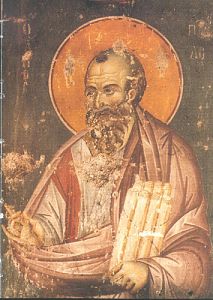 Born: c.69
Born: c.69Martyred: Stabbed to death c.155 at Smyrna Associate of, converted by, and disciple of Saint John the Apostle. Friend of Saint Ignatius of Antioch and Saint Papias. Fought Gnosticism. Bishop of Smyrna (modern Izmir, Turkey). Revered Christian leader during the first half of the second century. The Asia Minor churches recognized Polycarp's leadership and chose him representative to Pope Anicetus on the question the date of the Easter celebration. Only one of the many letters written by Polycarp has survived, the one he wrote to the Church of Philippi, Macedonia. At 86, Polycarp was to be burned alive in a stadium in Smyrna; the flames did not harm him and he was finally killed by a dagger, and his body burned. The Acts of Polycarp's martyrdom are the earliest preserved reliable account of a Christian martyr's death. Apostolic Father. Prayer Before Martyrdom... "Lord God almighty, Father of Jesus Christ, your dear Son through whom we have come to know you, God of the angels and powers, God of all creation, God of those who live in your presence, the race of the just: I bless you. You have considered me worthy of this day and hour, worthy to be numbered with the martyrs and to drink the cup of your Anointed One, and thus to rise and live forever, body and soul, in the incorruptibility of the Holy Spirit." - Saint Polycarp of Smyrna, Bishop and Martyr 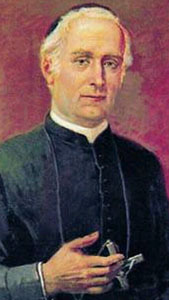 1831-1891, Italian.
1831-1891, Italian. Son of Dr Antonio Fusco, a pharmacist, and Stella Giordano, an Italian noble; seventh of eight children in a pious family. His mother died of cholera in 1837 when Tommaso was six, his father in 1841 when the boy was ten, and he was educated by his fraternal uncle Giuseppe, a priest and school teacher. Entered the seminary at Nocera, Italy in 1847, the same year his uncle Giuseppe died. Ordained on 22 December 1855. Opened a school for boys in his own home, and organized prayer groups at night in his parish. Joined the Congregation of the Missionaries of Nocera in 1857, and became a traveling missionary in southern Italy. Chaplain and spiritual director at the Shrine of Our Lady of Carmel (Our Lady of the Hens) in Pagani, Italy in 1860. Opened a school of moral theology in his home in 1862, and trained priests in the ministry of Confession. Founded the Priestly Society of the Catholic Apostolate to support missions, a congregation that received the approval of Pope Blessed Pius IX in 1874. Founded the Daughters of Charity of the Most Precious Blood on 6 January 1873, a congregation devoted to the care of orphans. Parish priest at San Felice e Corpo di Cristo at Pagani from 1874 to 1887. Confessor to cloistered nuns at Pagani and Nocera. Wrote on a number of topics including moral theology; his works always expressed his devotion to the Precious Blood. Late in life he was the victim of slander when a brother priest became jealous of Tommaso's good works and consequent notoriety. But Father Fusco prayed his way through the matter, continued his work, and was vindicated in the end. Beatified on Oct. 7, 2001 by Pope John Paul II. "May work and suffering for God always be your glory and in your work and suffering, may God be your consolation on this earth, and your recompense in heaven. Patience is the safeguard and pillar of all the virtues." - Blessed Tommaso Maria Fusco 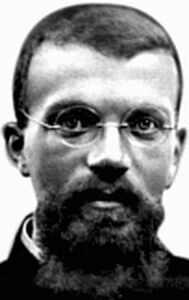 Italian, 1903-1930. Martyred in China.
Italian, 1903-1930. Martyred in China.Canonized by Pope John Paul II on October 1, 2000. Salesian missionary priest. One of the Martyrs of China. Callistus was sent to Macao, and then for two years to Timor where he edified everyone, including the rector, for his goodness and apostolic zeal. "My good mother", he wrote, "pray that your Callistus may not be just a half priest but completely the priest".  Bishop of Gaza, in the Holy Land.
Bishop of Gaza, in the Holy Land. b. Thessalonica, 347; d. at Gaza, 420. Born to wealth. Hermit in the desert of Skete, Egypt. Hermit in Palestine on the bank of the Jordan River. Reluctant bishop of Gaza, he took to this assignment with great zeal and devotion. He converted almost all of his diocese, and nearly eliminated paganism in it. Prayer... Hear our prayers, O Lord, offered by us on the feast of St. Porphyrius, Thy Confessor and Bishop; and by the interceding merits of him who was found worthy to serve You, free us from all sin. Through Our Lord Jesus Christ, Your Son, Who lives and reigns with You in the unity of the Holy Spirit, God, world without end. Amen. 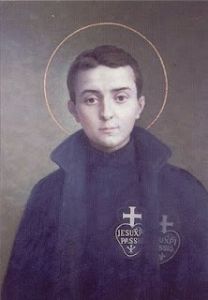 Born in Assisi, Italy, 1838
Born in Assisi, Italy, 1838Died in Abruzzi, Italy of tuberculosis, 1862 One of thirteen children. After a youth devoted to the world and society, attending the theater, chasing women and the hunt, he was led to the Passionist Order by Our Lady, making his profession on 22 September 1857. His life was not marked by great events or controversy, but given to prayer, sacrifice, and a devotion to Our Lady and the contemplation of her sorrows over the suffering of Jesus. Many miracles are attributed to him after his death. Cured Saint Gemma Galgani when she prayed for his intervention. Pope Benedict XV gave him as a pattern for young people. "Love Mary! She is lovable, faithful, constant. She will never let herself be outdone in love, but will ever remain supreme. If you are in danger, she will hasten to free you. If you are troubled, she will console you. If you are sick, she will bring you relief. If you are in need, she will help you. She does not look to see what kind of person you have been. She simply comes to a heart that wants to love her. She comes quickly and opens her merciful heart to you, embraces you and consoles and serves you. She will even be at hand to accompany you on the trip to eternity." - St. Gabriel Possenti "I will attempt day by day to break my will into pieces. I want to do God's Holy Will, not my own!" - Saint Gabriel Possenti 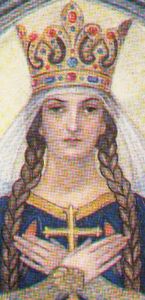 b. 1371-d. 1399, during childbirth. Miracles reported at her tomb.
b. 1371-d. 1399, during childbirth. Miracles reported at her tomb.Canonized by Pope John Paul II on June 8, 1997. Youngest daughter of King Louis I of Hungary. Because she was great-niece to King Casimir III of Poland, she became Queen of Poland in 1382 upon her father's death. She was engaged to William, Duke of Austria, whom she loved, but broke off the relationship in order to marry Jagiello, non-Christian Prince of Lithuania, at age 13 for political reasons. She offered her misery in this marriage to Christ, and she eventually converted her husband; Jagiello was later known as King Landislaus II of Poland after the unification of the kingdoms, a union that lasted over 400 years. Noted for her charity to all, but especially the sick and poor, and for a revision of the laws to help the poor. Loving God, may we care about other people like St. Hedwig did. Help us to share what we have and be generous to those who are sick and poor. May we look beyond our own lives to the needs of others. Help us to be caring and compassionate in Your Name. Amen.  d. 992
d. 992Oswald, of Danish parentage, was brought up by his uncle Oda, Archbishop of Canterbury, and was also related to Oskytel, later Archbishop of York Prayer: God present in the poor, help us to realize that serving the needs of others is something all of us are called to do. Let us be generous in giving to others. Let us give not only of our surplus but also of our time and energy. |




